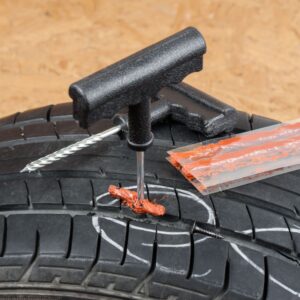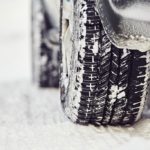Vehicle tires can take a lot of use and abuse. Punctures from nails and other sharp objects on tire treads are known to be easily repaired. However, punctures or cracks on a tire’s sidewalls are a completely different story. Sidewalls aren’t reinforced to protect against punctures on the road, and they aren’t designed to wear out like the tire tread, so they tend to be much thinner.
Tires experience a lot of stress at high speeds because of the enormous forces present. At the same time, tires also heat up because of the friction between the rubber and the road surface. If a tire’s sidewall has been damaged, the strenuous conditions could stress the tire to the point of failure. Tires with leaks or holes on the sidewall tend to warrant an immediate replacement.
Why Can’t You Repair Tires With Sidewall Damage?
When tires get punctured, they’re typically repaired using tire patch kits. The process typically involves removing the tire from the rim and cleaning the area around the hole or tear on the inside of the tire. Afterward, the patch is adhered to the hole with vulcanizing cement. The tire patch works effectively because once the tire is inflated, the patch is pressed onto the sides of the hole, which creates a secure seal that lasts the rest of the tire’s lifespan.
However, using tire patch kits on sidewalls is challenging because a tire’s sidewall tends to flex more than a tire’s tread. This flex can affect how well the patch adheres to the rubber. Ultimately, this extra stress on repaired sidewalls can increase the likelihood of patch failure, which is especially risky at high speeds.
To be clear, the unrepairable section is generally the sidewall and up to about the first section of the tread line, which is around 1.5 to 2 inches from the edge of the tire.
The tire tread’s unrepairable section is the sidewall and up to about the first section of tread line, which is around 1.5 to 2 inches from the edge of the tire.
–Anthony Harlin, ASE Certified Master Automobile Technician
Can You Repair Sidewall Damage With a Patch Kit?
You shouldn’t. At best, it’s a temporary solution, and most experts and tire manufacturers do not recommend repairing sidewalls. Try to have your tire replaced as soon as you can if it has sidewall damage. Don’t drive on the damaged tire.
Zipper punctures are also not repairable. These are essentially long cuts along the tire. Damage that is indicative of old tires like worn-out tread and cracks should warrant immediate replacement.

Sidewall Damage Types
There are distinct types of damage that drivers should be aware of.
Bubbles
One common type of sidewall damage is known as bulges or bubbles. This type of damage occurs when the tire’s internal structure is compromised, causing a noticeable outward protrusion on the sidewall. Impacts from potholes, curbs, or other road hazards are typically the main cause of bulges. Unlike punctures or cuts, bubbles might not necessarily cause a tire to deflate. However, bulges weaken the tire’s structural integrity and increase the risk of a blowout.
Cuts
Another type of sidewall damage is a cut or slice. This type of damage is typically caused by sharp objects on the road, such as glass shards, metal fragments, or other debris. Cuts and slices might not necessarily penetrate the tire’s sidewall. However, if there are cuts on the sidewall, they can potentially lead to leaks and a loss of tire pressure. Even seemingly minor cuts can compromise the tire’s overall structural integrity.
Fractures
Sidewall impact breaks occur when a tire has a severe impact, often from hitting a curb or a large obstacle. Impact breaks typically result in visible cracks or fractures on the sidewall. Just like cuts and bubbles, fractures significantly weaken the tire structure and pose a serious safety risk.
Puncture
Punctures are typically caused by thin, sharp objects like nails. The resulting hole is typically small. Punctures are perfectly repairable if they’re small and occur on the tread. However, even small punctures on the tire’s sidewall can compromise its structural integrity.
Cracks and Deformation
Cracks typically appear when tires are exposed to the sun and ozone. However, cracks typically appear when tires are nearing the end of their service life. Meanwhile, deformations appear like very minor creases on the surface. Slight deformations are common and shouldn’t affect the tire’s performance.
How To Find a Tire Sidewall Repair Near Me
You might find it difficult, if not impossible, to find a repair shop that will fix your tire’s damaged sidewalls. Most auto shops will recommend replacing the tire instead of patching up any cuts or cracks to the sidewall. This is because they follow strict tire repair guidelines, which include limiting repairs to the tread area only.
Most repair shops will also refuse to fix punctures that are greater than ¼ inch. Deep cuts are likely to slice through the tire’s steel belts, which can compromise the tire’s strength and durability.
Some drivers might feel frustrated at being refused this service, but keep in mind that they follow guidelines for a reason. Rather than being stingy, auto repair shops simply want to make sure you stay safe on the road.
At the end of the day, always remember sidewall repairs aren’t recommended by tire manufacturers and professionals. The risk of a blowout and a potential accident is too high. The accident will surely cost more than the cost of a new tire. A blowout will also damage the wheel itself, which isn’t cheap either.
There are many other ways to deal with sidewall damage, like pulling out your vehicle’s spare or buying a new tire altogether. Luckily, getting sidewall damage is unlikely since the tread takes most of the brunt on the road. More often than not, sidewall damage is caused by hitting curbs, overloading the vehicle, or underinflating the tire. You can avoid costly sidewall damage as long as you pay attention to road conditions, keep your tires properly inflated, and pay attention to your tires’ maintenance calendar.
Any information provided on this Website is for informational purposes only and is not intended to replace consultation with a professional mechanic. The accuracy and timeliness of the information may change from the time of publication.
































